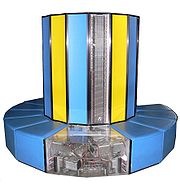- Red Storm (computing)
-
Red Storm is a supercomputer architecture designed for the US Department of Energy’s National Nuclear Security Administration Advanced Simulation and Computing Program. Cray, Inc developed it based on the contracted architectural specifications provided by Sandia National Laboratories.[1] The architecture was later commercially produced as the Cray XT3.[2]
Red Storm is a partitioned, space shared, tightly coupled, massively parallel processing machine with a high performance 3D mesh network. The processors are commodity AMD Opteron CPUs with off-the-shelf memory DIMMs. The NIC/router combination, called SeaStar, is the only custom ASIC component in the system and uses a PowerPC 440 based core. When deployed in 2005, Red Storm’s initial configuration consisted of 10,880 single-core 2.0 GHz Opterons, of which 10,368 were dedicated for scientific calculations. The remaining 512 Opterons were used to service the computations and also provide the user interface to the system and run a version of Linux. This initial installation consisted of 140 cabinets, taking up 280 square metres (3,000 sq ft) of floor space.
The Red Storm supercomputer was designed to be highly scalable from a single cabinet to hundreds of cabinets and has been scaled-up twice. In 2006 the system was upgraded to 2.4 GHz Dual-Core Opterons. An additional fifth row of computer cabinets were also brought online resulting in over 26,000 processor cores. This resulted in a peak performance of 124.4 teraflops, or 101.4 running the Linpack benchmark.[3] A second major upgrade in 2008 introduced Cray XT4 technology: Quad-core Opteron processors and an increase in memory to 2 GB per core. This resulted in a peak theoretical performance of 284 teraflops.[4]
Top 500 performance ranking for Red Storm after each upgrade:
- November 2005: Rank 6 (36.19 TFLOPS) [5]
- November 2006: Rank 2 (101.4 TFLOPS) [6]
- November 2008: Rank 9 (204.2 TFLOPS) [7]
Red Storm is intended for capability computing. That is, a single application can be run on the entire system. This is in contrast to cluster-style capacity computing, in which portions of a cluster are assigned to run different applications. The performance of the memory subsystem, the processor, and the network must be in proper balance to achieve adequate application progress across the entire machine. System software plays a key role as well. The Portals network programming API is used to ensure inter-processor communication can scale as large as the entire system, and has been used on many different supercomputers, including the Intel Teraflops and Paragon. The compute processors use a custom lightweight kernel operating system named Catamount, which is based on the operating system of ASCI Red called "Cougar".[8]
References
- ^ "Red Storm 2004 fact sheet" (Press release). 2004-06. http://www.sandia.gov/ASC/pubs_pres/pubs/RS_flyer.pdf. Retrieved 2009-08-11.
- ^ "Sandia Red Storm press release" (Press release). 2004-07-27. http://www.sandia.gov/news-center/news-releases/2004/comp-soft-math/redstormrising.html. Retrieved 2009-08-11.
- ^ "Red Storm upgrade lifts Sandia supercomputer to 2nd in world, but 1st in scalability, say researchers" (Press release). 2006-11-14. http://www.sandia.gov/news/resources/releases/2006/red-storm.html. Retrieved 2009-08-11.
- ^ "Cray and Sandia Announce Agreement to Upgrade "Red Storm" Supercomputer to 284 Teraflops" (Press release). February 06, 2008-02-06. http://investors.cray.com/phoenix.zhtml?c=98390&p=irol-newsArticle&ID=1104852. Retrieved 2009-08-11.
- ^ "Top 500 rankings for Nov 2005". 2005-11. http://www.top500.org/lists/2005/11. Retrieved 2009-08-11.
- ^ "Top 500 rankings for Nov 2006". 2006-11. http://www.top500.org/lists/2006/11. Retrieved 2009-08-11.
- ^ "Top 500 rankings for Nov 2008". 2008-11. http://www.top500.org/lists/2008/11. Retrieved 2009-08-11.
- ^ "Red Storm 2008 fact sheet" (Press release). 2008. http://www.sandia.gov/ASC/pubs-media/pubs/ASC_factsheet_RS_2008.pdf. Retrieved 2009-08-11.
Cray Research
Cray-1 • Cray X-MP • Cray-2 • Cray Y-MP • Cray XMS • Cray Y-MP EL
Cray C90 • Cray EL90 • Cray T3D • Cray J90 • Cray T90 • Cray T3E • Cray SV1
Cray Computer Corp.
Cray-3 • Cray-4
Cray Research Superservers
Cray APP • Cray S-MP • Cray CS6400
Cray Inc.
Cray SX-6 • Cray MTA-2 • Cray Red Storm • Cray X1 • Cray XT3 • Cray XD1
Cray XT4 • Cray XMT • Cray XT5 • Cray CX1 • Cray XT6 • Cray XE6 • Cray CX1000 • Cray XK6
This computer hardware article is a stub. You can help Wikipedia by expanding it.

